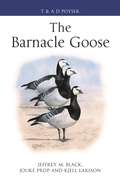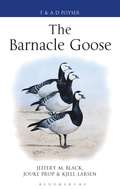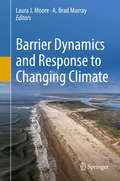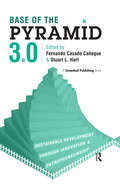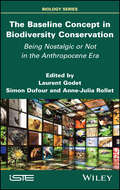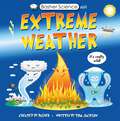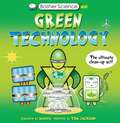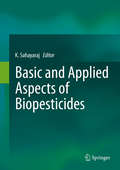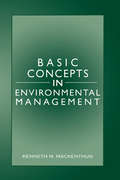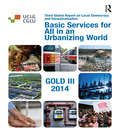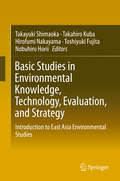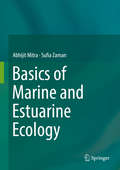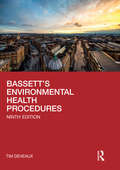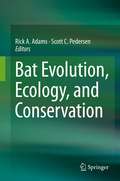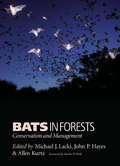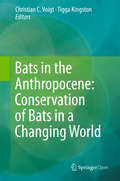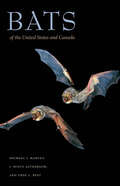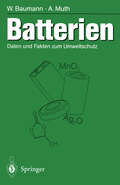- Table View
- List View
The Barn: The Lives, Landscape and Lost Ways of an Old Yorkshire Farm
by Sally CoulthardA revelatory uncovering of a vanished agricultural way of life by bestselling nature writer Sally Coulthard. 'A gem of a book' Country Smallholding 'Engaging and filled with gentle humour and fascinating facts' Get History 'Shows us the beauty and rich history of everyday things' Country Walking MagazineAcross the foldyard from Sally Coulthard's North Yorkshire farmhouse, stands an old stone barn. When she discovered a set of witches' marks on one of its internal walls, she began to wonder about the lives of the people who had once lived and worked there.Both the intimate story of a building and its hinterland, and a wider social history, The Barn explores a hidden corner of rural Britain that has witnessed remarkable changes. From the eighteenth-century Enclosures to the Second World War, the fortunes of the Barn have been blown, like a leaf in a gale, by the unstoppable forces of new agriculture and industry. Seismic shifts in almost every area of society were all played out here in miniature – against a backdrop of scattered limestone villages and the softly rolling Howardian Hills.
The Barnacle Goose
by Jeffrey M. Black Jouke Prop Kjell LarssonThe Barnacle Goose, a distinctive, handsome black-and-white bird, gets its name from a mediaeval myth that the birds hatched from barnacles – how else to explain their sudden appearance each autumn in northern Britain? We now know, of course, that the birds migrate from Arctic Russia, Norway and Svalbard to winter throughout northern Europe. This book represents a culmination of more than 25 years of Barnacle Goose research. It represents the story of one of Europe's most celebrated long-term behavioral studies, detailing the lives of these social and sociable birds. Chapters include sections on pair formation and bonding, family and population dynamics, brood parasitism, food and feeding, size and shape in different populations, life cycle, survivorship, dispersal, migration, and conservation, with particular regard to climate change. It is a rigorous and thorough examination of the lives of these birds, in fine Poyser tradition.
The Barnacle Goose
by Jeffrey M. Black Jouke Prop Kjell LarssonThe Barnacle Goose, a distinctive, handsome black-and-white bird, gets its name from a mediaeval myth that the birds hatched from barnacles – how else to explain their sudden appearance each autumn in northern Britain? We now know, of course, that the birds migrate from Arctic Russia, Norway and Svalbard to winter throughout northern Europe. This book represents a culmination of more than 25 years of Barnacle Goose research. It represents the story of one of Europe's most celebrated long-term behavioral studies, detailing the lives of these social and sociable birds. Chapters include sections on pair formation and bonding, family and population dynamics, brood parasitism, food and feeding, size and shape in different populations, life cycle, survivorship, dispersal, migration, and conservation, with particular regard to climate change. It is a rigorous and thorough examination of the lives of these birds, in fine Poyser tradition.
Barrier Dynamics and Response to Changing Climate
by Laura J. Moore A. Brad MurrayThis book presents chapters, written by leading coastal scientists, which collectively depict the current understanding of the processes that shape barrier islands and barrier spits, with an emphasis on the response of these landforms to changing conditions. A majority of the world’s population lives along the coast at the dynamic intersection between terrestrial and marine ecosystems and landscapes. As narrow, low-lying landforms, barriers are especially vulnerable to changes in sea level, storminess, the geographic distribution of grass species, and the rate of sand supply—some barriers will undergo rapid changes in state (e.g., from landward migrating to disintegrating), on human time scales. Attempts by humans to prevent change can hasten the loss of these landforms, threatening their continued existence as well as the recreational, financial and ecosystem service benefits they provide. Understanding the processes and interactions that drive landscape response to climate change and human actions is essential to adaptation. As managers and governments struggle to plan for the future along low-lying coasts worldwide, and scientists conduct research that provides useful guidance, this volume offers a much-needed compilation for these groups, as well as a window into the science of barrier dynamics for anyone who is generally interested in the impacts of a changing world on coastal environments.
Base of the Pyramid 3.0: Sustainable Development through Innovation and Entrepreneurship
by Fernando Casado Caneque Stuart L. HartFor well over 4 billion people – approximately 60% of all humanity – annual income is less than $1,500. The term "Base of the Pyramid" was first coined by Stuart L. Hart and C.K. Prahalad in 2002 and has become synonymous with both the method by which we can more effectively address poverty and the opportunity that exists in a multi-trillion-dollar market. A whole new lexicon has emerged to describe this phenomenon, including new buzzwords and catch phrases like "inclusive business", "opportunities for the majority", "sustainable livelihoods", "pro-poor business" and “social business”, and thousands of new businesses, institutions and investment funds have been set up.In this ground-breaking new book, Stuart L. Hart and Fernando Casado Cañeque have worked with members of the BoP Global Network to shake the tree, look objectively at what has happened since 2002, highlight why earlier applications of BoP haven’t worked and propose new objectives and ways of working to formulate more sustainable solutions. The book challenges the reader and organizations to think about the mindset and purpose across whole organizations, open innovation rather than simply co-creation, and a complete review of the innovation ecosystem. Through this book, practitioners will gain a clearer insight into which business models can work within different communities to ensure a sustainable transition to improved local economies. Equally, the book is a must-read for researchers and students in the fields of entrepreneurship, innovation, sustainable development and environmental management.
Base of the Pyramid 3.0: Sustainable Development through Innovation and Entrepreneurship
by Fernando Casado Caneque Stuart L. HartFor well over 4 billion people – approximately 60% of all humanity – annual income is less than $1,500. The term "Base of the Pyramid" was first coined by Stuart L. Hart and C.K. Prahalad in 2002 and has become synonymous with both the method by which we can more effectively address poverty and the opportunity that exists in a multi-trillion-dollar market. A whole new lexicon has emerged to describe this phenomenon, including new buzzwords and catch phrases like "inclusive business", "opportunities for the majority", "sustainable livelihoods", "pro-poor business" and “social business”, and thousands of new businesses, institutions and investment funds have been set up.In this ground-breaking new book, Stuart L. Hart and Fernando Casado Cañeque have worked with members of the BoP Global Network to shake the tree, look objectively at what has happened since 2002, highlight why earlier applications of BoP haven’t worked and propose new objectives and ways of working to formulate more sustainable solutions. The book challenges the reader and organizations to think about the mindset and purpose across whole organizations, open innovation rather than simply co-creation, and a complete review of the innovation ecosystem. Through this book, practitioners will gain a clearer insight into which business models can work within different communities to ensure a sustainable transition to improved local economies. Equally, the book is a must-read for researchers and students in the fields of entrepreneurship, innovation, sustainable development and environmental management.
The Baseline Concept in Biodiversity Conservation: Being Nostalgic or Not in the Anthropocene Era
by Laurent Godet Simon Dufour Anne-Julia RolletThe Anthropocene era has been marked by such significant human pressure that it has led to the sixth mass extinction. The Baseline Concept in Biodiversity Conservation interprets human domination of the Earth as the process of gradual landscape change, the execution of which is neither linear nor homogeneous. This book is structured around three key questions: Where and when did everything go wrong? How do we define baseline states for biodiversity conservation strategies? How are reference states mobilized in a concrete way through case studies? Today, biodiversity conservation faces a dilemma that this book sheds light on: return to states less modified by humans than today but in a world that has changed significantly; or, let the nature of tomorrow express itself where it still can but without a road map.
The Baseline Concept in Biodiversity Conservation: Being Nostalgic or Not in the Anthropocene Era
by Laurent Godet Simon Dufour Anne-Julia RolletThe Anthropocene era has been marked by such significant human pressure that it has led to the sixth mass extinction. The Baseline Concept in Biodiversity Conservation interprets human domination of the Earth as the process of gradual landscape change, the execution of which is neither linear nor homogeneous. This book is structured around three key questions: Where and when did everything go wrong? How do we define baseline states for biodiversity conservation strategies? How are reference states mobilized in a concrete way through case studies? Today, biodiversity conservation faces a dilemma that this book sheds light on: return to states less modified by humans than today but in a world that has changed significantly; or, let the nature of tomorrow express itself where it still can but without a road map.
Basher Science Mini: It's really wild!
by Tom JacksonThings are hotting up, but not in a good way! Every year, millions of people across the globe find themselves at the mercy of Heat Wave, Drought or Flood – they’re friends of Climate Change, who is wreaking havoc on our planet.Step inside to learn more about these extreme characters. But first, let Weather System, Seasons and Climate tell you how weather works. Find out just what it is about Climate Change that is making things more intense. And whatever you do, don’t panic! Just as there are troublemakers in this turbulent world, there are heroes who want to calm things down: Flood Defences and Firefighting will bring you up to speed.Basher Science Mini: Extreme Weather gives kids the lowdown on one of the most pressing problems that we face: extreme weather. Basher's unique illustrations combine with chatty, first-person text by expert author Tom Jackson to hook even the most reluctant readers and help them to understand the science behind the headlines.Perfect for home or school, Basher's highly original books make difficult concepts tangible, understandable and even lovable. With sales of over 3 million copies around the world, they are a brilliant way to communicate science, history and geography.
Basher Science Mini: Green Technology (Basher #138)
by Tom JacksonWorld, we’ve got a problem! Climate Change. Make that two problems as Pollution is in the frame. In Basher Science Mini: Green Technology, scientific wizardry rides to the planet’s rescue. From saving the birds and the bees, to cleaning up the seas and waving goodbye to plastics, green tech is part of the solution to climate change. Some solutions are really out there, take a bow Space Mirrors, while others are close to home, we see you, Solar Panels! And you, too, Electric Vehicle! Our motto is protect and repair. Let’s get started.Perfect for home or school, Basher's highly original books make difficult concepts tangible, understandable and even lovable. Chatty first-person text and stylish, contemporary character illustrations give a voice, personality and story to each topic – a brilliant way to communicate science.
Basic and Applied Aspects of Biopesticides
by K. SahayarajCurrently, the major challenge of humanity is focused on population growth through agricultural production in order to meet the demand for food. The food crunch is mainly due to pest and disease. Traditional methods, synthetic insecticides and microbicides cause health hazards to human beings, domestic animals and also affect our immediate environments. Serious concerns were implemented by both developing and developed countries as Integrated Pest Management (IPM) and Bio-intensive Integrated Pest Management (BIPM) systems where biopesticides play an important role worldwide. The available books are limited to particular aspects of biopesticides. Hence, it is imperative to bring out a holistic documentation which will provide the reader information on all aspects of biopesticides. The book consists of five sections namely microbials, botanicals, natural enemies semio- chemicals and biotechnology and equipments, bioinformatics tools and IPM. In Section I, microbial deals with utilization of Bacillus in control of phytonematodes; biological control of pest and diseases with fluorescent pseudomonads, entomopathogenic fungus and entomopathogenic nematodes in pest management, microbial viral insecticides and microbial elicitors to induce immunity for plant disease control in chilli and tomato. Importance of plant essential oils, botanicals in endocrine disruption, relevance of botanicals and use of plant volatile on pest management has been discussed in Section II. Importance and role of reduviidae, weaver ants, ground beetles, Odonatas, spiders in biological control has been discussed in Section III. In addition, genetic improvement of biocontrol agents for sustainable pest management has also been highlighted. In Section IV, classical practices and pheromone, kairomonal enhancement to natural enemies and use of transgenic plants in insect control are highlighted. Equipment and their application methodologies for application of biopesticides; relevance of bioinformatics in biopesticides management; pest management of soybean, bio fouling and eco friendly antifoulants have been highlighted in Section V. Each chapter has objectives and conclusion along with recommendations.
Basic Concepts in Environmental Management
by Kenneth M. MackenthunEnvironmental professionals are (and will continue to be) under increased pressure to become more knowledgeable of environmental management issues.Basic Concepts in Environmental Management fulfills the long-standing need for fundamental knowledge-especially concerning government regulations on environmental and natural resource protection.As a leading environmental professional and consultant since the 1940s, Kenneth M. Mackenthun offers a unique perspective on the breadth, scope, and ever-constant change in environmental legislation at the federal, state, and local levels... and what those guidelines signify for industry and citizens alike.By maintaining an awareness of existing and forthcoming laws, environmentalists can substantially enhance their career potential-and be in a better position to protect the land, air, and sea. The starting point for that knowledge: Basic Concepts in Environmental Management.
Basic Concepts in Environmental Management
by Kenneth M. MackenthunEnvironmental professionals are (and will continue to be) under increased pressure to become more knowledgeable of environmental management issues.Basic Concepts in Environmental Management fulfills the long-standing need for fundamental knowledge-especially concerning government regulations on environmental and natural resource protection.As a leading environmental professional and consultant since the 1940s, Kenneth M. Mackenthun offers a unique perspective on the breadth, scope, and ever-constant change in environmental legislation at the federal, state, and local levels... and what those guidelines signify for industry and citizens alike.By maintaining an awareness of existing and forthcoming laws, environmentalists can substantially enhance their career potential-and be in a better position to protect the land, air, and sea. The starting point for that knowledge: Basic Concepts in Environmental Management.
Basic Services for All in an Urbanizing World
by United Cities And Local Governments StaffUCLG’s Third Global Report on Local Democracy and Decentralization (GOLD III) examines basic service provision and the current state-of-play of the local governance of basic services around the world. Basic Services for All in an Urbanizing World examines the enormous challenge of ensuring the universal provision of basic services in a world that is being shaped by rapid global urbanization, climate change, and economic, social and technological transformation. The world’s urban population is predicted to reach 5 billion people within the next 20-30 years. The report analyses the conditions necessary for local governments to provide these new urban residents with quality basic services. Water, sanitation, waste management, transport and energy are essential, not only for the preservation of human life and dignity, but also in driving economic growth and ensuring social equality. Each chapter examines a world region, drawing on existing research and consultation with local authorities on the ground. The chapters review access levels, legal and institutional frameworks, and the different ways in which basic services are managed and financed, as well as showcasing diverse examples of innovation in the local and multi-level governance of services. It concludes with a set of recommendations for all stakeholders with a view to making the goal of basic services for all a reality. This report contributes to discussions on the Millennium Development Goals and the UN Post-2015 Development Agenda. The findings of GOLD III will also be essential to promoting the vision of local governments at the 2016 UN Conference on Human Settlements (Habitat III).
Basic Services for All in an Urbanizing World
by UclgUCLG’s Third Global Report on Local Democracy and Decentralization (GOLD III) examines basic service provision and the current state-of-play of the local governance of basic services around the world. Basic Services for All in an Urbanizing World examines the enormous challenge of ensuring the universal provision of basic services in a world that is being shaped by rapid global urbanization, climate change, and economic, social and technological transformation. The world’s urban population is predicted to reach 5 billion people within the next 20-30 years. The report analyses the conditions necessary for local governments to provide these new urban residents with quality basic services. Water, sanitation, waste management, transport and energy are essential, not only for the preservation of human life and dignity, but also in driving economic growth and ensuring social equality. Each chapter examines a world region, drawing on existing research and consultation with local authorities on the ground. The chapters review access levels, legal and institutional frameworks, and the different ways in which basic services are managed and financed, as well as showcasing diverse examples of innovation in the local and multi-level governance of services. It concludes with a set of recommendations for all stakeholders with a view to making the goal of basic services for all a reality. This report contributes to discussions on the Millennium Development Goals and the UN Post-2015 Development Agenda. The findings of GOLD III will also be essential to promoting the vision of local governments at the 2016 UN Conference on Human Settlements (Habitat III).
Basic Studies in Environmental Knowledge, Technology, Evaluation, and Strategy: Introduction to East Asia Environmental Studies
by Takayuki Shimaoka Takahiro Kuba Hirofumi Nakayama Toshiyuki Fujita Nobuhiro HoriiThis book covers diverse environmental issues such as climate change; biodiversity preservation; prevention of air, water, and soil pollution; and resource recycling. Readers can acquire these four practical interdisciplinary abilities: 1. knowledge; 2. technology; 3. evaluation; and 4. strategy in the diverse issues related to the environment. These abilities are fundamental to identifying the core essence of economic and ecological interdependence, to look at and analyze problems from an overarching perspective, and to consider countermeasures to be taken. Each chapter of this book corresponds to a lecture in the East Asia Environmental Strategist Training Program at Kyushu University and is excellent reading as a sourcebook.
Basics of Marine and Estuarine Ecology
by Abhijit Mitra Sufia ZamanThe book presents recent research on marine ecology in different parts of the world. It aims to shed light on relevant topics for budding marine ecologists.The “blue soup” of Planet Earth, which comprises both biotic and abiotic components, is essential to keeping the wheel of civilization running. Four major ecosystem service categories have been identified within this context, namely provisioning services such as water, food, mangrove timber, honey, fish, wax, fuel wood, fodder and bioactive compounds from marine and estuarine flora and fauna; regulating services such as the regulation of climate, coastal erosion, coral bleaching and pollution; cultural services encompassing recreational (tourism), spiritual and other non-material benefits; and supporting services such as nutrient cycling and photosynthesis. These valuable services are obtained from various resources that must be conserved for the sake of humanity. This book presents data for each resource type, not just in the form of a simple description, but also through case studies that resulted from several research projects and pilot programs carried out in different parts of the world. Statistical tools were also used to critically analyze the influence of relevant hydrological parameters on the biotic community. Advanced research in marine and estuarine ecology is based on the use of sophisticated instruments, sampling precision, statistical tools, etc., which have also been highlighted in the book.
Bassett's Environmental Health Procedures
by W.H. Bassett Tim DeveauxEnvironmental health law is a wide-ranging, detailed and complex body of law within the UK. Bassett’s Environmental Health Procedures is an established and essential reference source which provides an accessible entry into enforcement and administrative procedures for environmental health. The main legal procedures used in the environmental health field are presented as flow charts supported by explanatory text. This ninth edition refines the structure introduced in the eighth edition, with each chapter addressing a single topic. It has introduced the titles of the corresponding legislation in Scotland and Northern Ireland where there is such legislation. The book has been updated throughout to reflect new practices, legislation and statutory guidance. Specifically, the ninth edition contains new content on Antisocial Behaviour and significant updates to sections on: Enforcement and Administration Environmental Protection Food Safety Housing and Public Health Environmental Health Officers/Practitioners and students will find this book invaluable. It will also be an essential reference for all those whose responsibilities demand they keep abreast of current environmental health practices.
Bassett's Environmental Health Procedures
by W.H. Bassett Tim DeveauxEnvironmental health law is a wide-ranging, detailed and complex body of law within the UK. Bassett’s Environmental Health Procedures is an established and essential reference source which provides an accessible entry into enforcement and administrative procedures for environmental health. The main legal procedures used in the environmental health field are presented as flow charts supported by explanatory text. This ninth edition refines the structure introduced in the eighth edition, with each chapter addressing a single topic. It has introduced the titles of the corresponding legislation in Scotland and Northern Ireland where there is such legislation. The book has been updated throughout to reflect new practices, legislation and statutory guidance. Specifically, the ninth edition contains new content on Antisocial Behaviour and significant updates to sections on: Enforcement and Administration Environmental Protection Food Safety Housing and Public Health Environmental Health Officers/Practitioners and students will find this book invaluable. It will also be an essential reference for all those whose responsibilities demand they keep abreast of current environmental health practices.
Bat Evolution, Ecology, and Conservation
by Rick A. Adams and Scott C. PedersenRecent advances in the study of bats have changed the way we understand this illusive group of mammals. This volume consist of 25 chapters and 57 authors from around the globe all writing on the most recent finding on the evolution, ecology and conservation of bats. The chapters in this book are not intended to be exhaustive literature reviews, but instead extended manuscripts that bring new and fresh perspectives. Many chapters consist of previously unpublished data and are repetitive of new insights and understanding in bat evolution, ecology and conservation. All chapters were peer-reviewed and revised by the authors. Many of the chapters are multi-authored to provide comprehensive and authoritative coverage of the topics.
Bats in Forests: Conservation and Management
by John P. Hayes Allen Kurta Michael J. LackiAlthough bats are often thought of as cave dwellers, many species depend on forests for all or part of the year. Of the 45 species of bats in North America, more than half depend on forests, using the bark of trees, tree cavities, or canopy foliage as roosting sites. Over the past two decades it has become increasingly clear that bat conservation and management are strongly linked to the health of forests within their range. Initially driven by concern for endangered species—the Indiana bat, for example—forest ecologists, timber managers, government agencies, and conservation organizations have been altering management plans and silvicultural practices to better accommodate bat species. Bats in Forests presents the work of a variety of experts who address many aspects of the ecology and conservation of bats. The chapter authors describe bat behavior, including the selection of roosts, foraging patterns, and seasonal migration as they relate to forests. They also discuss forest management and its influence on bat habitat. Both public lands and privately owned forests are considered, as well as techniques for monitoring bat populations and activity.The important role bats play in the ecology of forests—from control of insects to nutrient recycling—is revealed by a number of authors. Bat ecologists, bat conservationists, forest ecologists, and forest managers will find in this book an indispensable synthesis of the topics that concern them.
Bats in the Anthropocene: Conservation of Bats in a Changing World
by Christian C. Voigt Tigga KingstonThis book focuses on central themes related to the conservation of bats. It details their response to land-use change and management practices, intensified urbanization and roost disturbance and loss. Increasing interactions between humans and bats as a result of hunting, disease relationships, occupation of human dwellings, and conflict over fruit crops are explored in depth. Finally, contributors highlight the roles that taxonomy, conservation networks and conservation psychology have to play in conserving this imperilled but vital taxon.With over 1300 species, bats are the second largest order of mammals, yet as the Anthropocene dawns, bat populations around the world are in decline. Greater understanding of the anthropogenic drivers of this decline and exploration of possible mitigation measures are urgently needed if we are to retain global bat diversity in the coming decades. This book brings together teams of international experts to provide a global review of current understanding and recommend directions for future research and mitigation.
Bats of the United States and Canada
by Michael J. Harvey J. Scott Altenbach Troy L. BestThe only mammals capable of true flight, bats are among the world’s most fascinating creatures. This accessible guide to the forty-seven species of bats found in the United States and Canada captures and explains the amazing diversity of these marvels of evolution.A wide variety of bat species live in the United States and Canada, ranging from the California leaf-nosed bat to the Florida bonneted bat, from the eastern small-footed bat to the northern long-eared bat. The authors provide an overview of bat classification, biology, feeding behavior, habitats, migration, and reproduction. They discuss the ever-increasing danger bats face from destruction of habitat, wind turbines, chemical toxicants, and devastating diseases like white-nose syndrome, which is killing millions of cave bats in North America. Illustrated species accounts include range maps and useful identification tips. Written by three of the world’s leading bat experts and featuring J. Scott Altenbach's stunning photographs, this fact-filled and easy-to-use book is the most comprehensive and up-to-date account of bats in the U.S. and Canada.
Bats of the United States and Canada
by Michael J. Harvey J. Scott Altenbach Troy L. BestThe only mammals capable of true flight, bats are among the world’s most fascinating creatures. This accessible guide to the forty-seven species of bats found in the United States and Canada captures and explains the amazing diversity of these marvels of evolution.A wide variety of bat species live in the United States and Canada, ranging from the California leaf-nosed bat to the Florida bonneted bat, from the eastern small-footed bat to the northern long-eared bat. The authors provide an overview of bat classification, biology, feeding behavior, habitats, migration, and reproduction. They discuss the ever-increasing danger bats face from destruction of habitat, wind turbines, chemical toxicants, and devastating diseases like white-nose syndrome, which is killing millions of cave bats in North America. Illustrated species accounts include range maps and useful identification tips. Written by three of the world’s leading bat experts and featuring J. Scott Altenbach's stunning photographs, this fact-filled and easy-to-use book is the most comprehensive and up-to-date account of bats in the U.S. and Canada.

